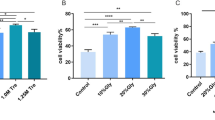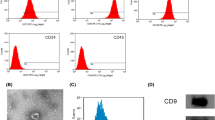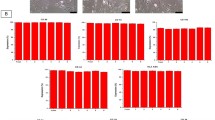Abstract
Cryoinjury mitigation is key in cell cryopreservation. Here, we aimed to assess the effectiveness of nanographene oxide (nano-GO) for improving cryoprotectant agents (CPAs) in human adipose stem cell (hADSC) cryopreservation. For in vitro experiments, nano-GO (5 μg/mL) was added to the CPAs in the control, and passage (P) 2 hADSCs were collected and cryopreserved for around two weeks. We compared cytotoxicity, cell viability, immunophenotypes, proliferation, cell apoptosis, and tri-lineage differentiation. In vivo, studies used lipoaspirate to create non-enriched or hADSC-enriched fat tissues by combining it with PBS or hADSCs cryopreserved with the aforementioned CPAs. Each nude mouse received a 0.3 mL subcutaneous injection of the graft. At 12 weeks, the grafts were harvested. Histology, adipocyte-associated genes and protein, vascular density and angiogenic cytokines, macrophage infiltration, and inflammatory cytokines were analyzed. Nano-GO CPA contributed to increased cell viability, improved cell recovery, and lowered levels of early apoptosis. Nano GO at concentrations of 0.01–100 μg/mL caused no cytotoxicity to hADSCs. The absence of nano GOs in the intracellular compartments of the cells was confirmed by transmission electron microscopy. The fat grafts from the CPA-GO group showed more viable adipocytes and significantly increased angiogenesis compared to the PBS and CPA-C groups. Adding hADSCs from the CPA-GO group to the graft reduced macrophage infiltration and MCP-1 expression. Nano-GO plays an anti-apoptotic role in the cryopreservation of hADSCs, which could improve the survival of transplanted fat tissues, possibly via improved angiogenesis and lower inflammatory response in the transplanted adipose tissue.


















Similar content being viewed by others
Data availability
No datasets were generated or analysed during the current study.
Abbreviations
- ANOVA:
-
Analysis of variance
- CAMS:
-
CAMS Initiative for Innovative Medicine
- CPA:
-
Cryoprotectant agents
- DMEM:
-
Dulbecco's Modified Eagle Medium
- ELISA:
-
Enzyme-linked immunosorbent assay
- FBS:
-
Fetal bovine serum
- MSC:
-
Mesenchymal stem cell
- PBS:
-
Phosphate-buffered saline
- ROS:
-
Reactive oxygen species
- TEM:
-
Transmission electron microscope
- VEGF:
-
Vascular endothelial growth factor
References
Acker JP, McGann LE (2003) Protective effect of intracellular ice during freezing? Cryobiology 46(2):197–202
Anchordoguy TJ et al (1991) Insights into the cryoprotective mechanism of dimethyl sulfoxide for phospholipid bilayers. Cryobiology 28(5):467–473
Bahsoun S, Coopman K, Akam EC (2019) The impact of cryopreservation on bone marrow-derived mesenchymal stem cells: a systematic review. J Transl Med 17(1):397
Balapanuru J et al (2010) A graphene oxide-organic dye ionic complex with DNA-sensing and optical-limiting properties. Angew Chem Int Ed Engl 49(37):6549–6553
Bárcia RN et al (2017) Umbilical cord tissue-derived mesenchymal stromal cells maintain immunomodulatory and angiogenic potencies after cryopreservation and subsequent thawing. Cytotherapy 19(3):360–370
Bernabo N et al (2018) Graphene oxide affects in vitro fertilization outcome by interacting with sperm membrane in an animal model. Carbon 129:428
Chen GY et al (2012) A graphene-based platform for induced pluripotent stem cells culture and differentiation. Biomaterials 33(2):418–427
Chinnadurai R et al (2014) Actin cytoskeletal disruption following cryopreservation alters the biodistribution of human mesenchymal stromal cells in vivo. Stem Cell Rep 3(1):60–72
Choi Y-J et al (2016) A novel biomolecule-mediated reduction of graphene oxide: a multifunctional anti-cancer agent. Molecules (basel, Switzerland) 21(3):375–375
Chong Yu et al (2015) Reduced cytotoxicity of graphene nanosheets mediated by blood-protein coating. ACS Nano 9(6):5713–5724
Connor W, Ashwood-Smith MJ (1973) Cryoprotection of mammalian cells in tissue culture with polymers; possible mechanisms. Cryobiology 10(6):488–496
Devireddy RV, Thirumala S, Gimble JM (2005) Cellular response of adipose derived passage-4 adult stem cells to freezing stress. J Biomech Eng 127(7):1081–1086
Du Z et al (2020) Applications of graphene and its derivatives in bone repair: advantages for promoting bone formation and providing real-time detection, challenges and future prospects. Int J Nanomed 15:7523–7551
Duan G et al (2015) Protein corona mitigates the cytotoxicity of graphene oxide by reducing its physical interaction with cell membrane. Nanoscale 7(37):15214–15224
Duan G et al (2017) Graphene-induced pore formation on cell membranes. Sci Rep 7:42767–42767
Durandt C et al (2019) The effect of early rounds of ex vivo expansion and cryopreservation on the adipogenic differentiation capacity of adipose-derived stromal/stem cells. Sci Rep 9(1):15943
Eto H et al (2012) The fate of adipocytes after nonvascularized fat grafting: evidence of early death and replacement of adipocytes. Plast Reconstr Surg 129(5):1081–1092
Farrant J (1969) Is there a common mechanism of protection of living cells by polyvinylpyrrolidone and glycerol ding freezing? Nature 222(5199):1175–1176
Feng Z-Q et al (2018) Neurogenic differentiation of adipose derived stem cells on graphene-based mat. Mater Sci Eng C Mater Biol Appl 90:685–692
François M et al (2012) Cryopreserved mesenchymal stromal cells display impaired immunosuppressive properties as a result of heat-shock response and impaired interferon-γ licensing. Cytotherapy 14(2):147–152
Franke WW, Hergt M, Grund C (1987) Rearrangement of the vimentin cytoskeleton during adipose conversion: formation of an intermediate filament cage around lipid globules. Cell 49(1):131–141
Gao D, Critser JK (2000) Mechanisms of cryoinjury in living cells. ILAR J 41(4):187–196
Garcia-Alegria E et al (2016) Graphene oxide promotes embryonic stem cell differentiation to haematopoietic lineage. Sci Rep 6:25917–25917
Garg J et al (2008) Enhanced thermal conductivity and viscosity of copper nanoparticles in ethylene glycol nanofluid. J Appl Phys 103(7):074301
Geng H et al (2017) Size fractionation of graphene oxide nanosheets via controlled directional freezing. J Am Chem Soc 139(36):12517–12523
Geng H et al (2017) Graphene oxide restricts growth and recrystallization of ice crystals. Angew Chem Int Ed Engl 56(4):997–1001
Gu Z et al (2015) The role of basic residues in the adsorption of blood proteins onto the graphene surface. Sci Rep 5:10873–10873
Guess AJ et al (2017) Safety profile of good manufacturing practice manufactured interferon gamma-primed mesenchymal stem/stromal cells for clinical trials. Stem Cells Transl Med 6(10):1868–1879
Guven S, Demirci U (2012) Integrating nanoscale technologies with cryogenics: a step towards improved biopreservation. Nanomedicine (london) 7(12):1787–1789
Haack-Sorensen M et al (2007) The influence of freezing and storage on the characteristics and functions of human mesenchymal stromal cells isolated for clinical use. Cytotherapy 9(4):328–337
Hajmousa G et al (2017) The 6-chromanol derivate SUL-109 enables prolonged hypothermic storage of adipose tissue-derived stem cells. Biomaterials 119:43–52
Halim A et al (2018) A mini review focused on the recent applications of graphene oxide in stem cell growth and differentiation. Nanomaterials (basel, Switzerland) 8(9):736
Han J et al (2018) Dual roles of graphene oxide to attenuate inflammation and elicit timely polarization of macrophage phenotypes for cardiac repair. ACS Nano 12(2):1959–1977
Harris WM et al (2019) Endothelial differentiated adipose-derived stem cells improvement of survival and neovascularization in fat transplantation. Aesthet Surg J 39(2):220–232
Hassell T, Gleave S, Butler M (1991) Growth inhibition in animal cell culture. The effect of lactate and ammonia. Appl Biochem Biotechnol 30(1):29–41
He Z, Liu K, Wang J (2018) Bioinspired materials for controlling ice nucleation, growth, and recrystallization. Acc Chem Res 51(5):1082–1091
Heid H et al (2014) On the formation of lipid droplets in human adipocytes: the organization of the perilipin-vimentin cortex. PLoS ONE 9(2):e90386
Hezavehei M et al (2019) Preconditioning of sperm with sublethal nitrosative stress: a novel approach to improve frozen-thawed sperm function. Reprod Biomed Online 38(3):413–425
Ishiguro H, Rubinsky B (1994) Mechanical interactions between ice crystals and red blood cells during directional solidification. Cryobiology 31(5):483–500
Kamat P et al (2020) Adipose tissue and the vascularization of biomaterials: Stem cells, microvascular fragments and nanofat-a review. Cytotherapy 22(8):400–411
Karimi-Busheri F, Rasouli-Nia A, Weinfeld M (2016) Key issues related to cryopreservation and storage of stem cells and cancer stem cells: protecting biological integrity. Adv Exp Med Biol 951:1–12
Kern S et al (2006) Comparative analysis of mesenchymal stem cells from bone marrow, umbilical cord blood, or adipose tissue. Stem Cells (dayton, Ohio) 24(5):1294–1301
Khalil WA et al (2019) Impact of selenium nano-particles in semen extender on bull sperm quality after cryopreservation. Theriogenology 126:121–127
Kim J et al (2013) Bioactive effects of graphene oxide cell culture substratum on structure and function of human adipose-derived stem cells. J Biomed Mater Res A 101(12):3520–3530
Kim WS, Park HS, Sung JH (2015) The pivotal role of PDGF and its receptor isoforms in adipose-derived stem cells. Histol Histopathol 30(7):793–799
Kim YW et al (2018) Insulin promotes adipose-derived stem cell differentiation after fat grafting. Plast Reconstr Surg 142(4):927–938
Kølle S-F et al (2013) Enrichment of autologous fat grafts with ex-vivo expanded adipose tissue-derived stem cells for graft survival: a randomised placebo-controlled trial. Lancet (london, England) 382(9898):1113–1120
Larionova I et al (2020) Tumor-associated macrophages in human breast, colorectal, lung, ovarian and prostate cancers. Front Oncol 10:566511
Li J, Li Z, Wang B (2002) Experimental viscosity measurements for copper oxide nanoparticle suspensions. Tsinghua Sci Technol 7(2):198–201
Li R et al (2018) Surface oxidation of graphene oxide determines membrane damage, lipid peroxidation, and cytotoxicity in macrophages in a pulmonary toxicity model. ACS Nano 12(2):1390–1402
Li Z et al (2020) The cell yields and biological characteristics of stromal/stem cells from lipoaspirate with different digestion loading ratio. Cytotechnology 72:203
Li P, Nijhawan D, Wang X (2004) Mitochondrial activation of apoptosis. 116(2 Suppl):S57–S61
Liao C, Li Y, Tjong SC (2018) Graphene nanomaterials: synthesis, biocompatibility, and cytotoxicity. Int J Mol Sci 19(11):3564
Lin C-F et al (2004) Sequential caspase-2 and caspase-8 activation upstream of mitochondria during ceramideand etoposide-induced apoptosis. J Biol Chem 279(39):40755–40761
Little JW 3rd, Munasifi T, McCulloch DT (1983) One-stage reconstruction of a projecting nipple: the quadrapod flap. Plast Reconstr Surg 71(1):126–133
Liu X et al (2016) Quantification of intracellular ice formation and recrystallization during freeze-thaw cycles and their relationship with the viability of pig iliac endothelium cells. Biopreserv Biobank 14(6):511–519
Lo Sicco C et al (2017) Mesenchymal stem cell-derived extracellular vesicles as mediators of anti-inflammatory effects: endorsement of macrophage polarization. Stem Cells Transl Med 6(3):1018–1028
Loutfy SA et al (2017) Synthesis, characterization and cytotoxic evaluation of graphene oxide nanosheets: in vitro liver cancer model. Asian Pac J Cancer Prevent (APJCP) 18(4):955–961
Lu F et al (2009) Improvement of the survival of human autologous fat transplantation by using VEGF-transfected adipose-derived stem cells. Plast Reconstr Surg 124(5):1437–1446
Ma W et al (2018) Neural induction potential and MRI of ADSCs labeled cationic superparamagnetic iron oxide nanoparticle in vitro. Contrast Media Mol Imaging 2018:6268437
Madden PW et al (1993) The effect of polyvinylpyrrolidone and the cooling rate during corneal cryopreservation. Cryobiology 30(2):135–157
Mazur P (1984) Freezing of living cells: mechanisms and implications. Am J Physiol 247(3 Pt 1):C125
Mcgrath JJ (1985) Preservation of biological material by freezing and thawing. Springer, New York
Miyazaki T, Suemori H (2016) Slow cooling cryopreservation optimized to human pluripotent stem cells. Adv Exp Med Biol 951:57–65
Morris GJ (2006) Rapidly cooled human sperm: no evidence of intracellular ice formation. Human Reprod (oxford, England) 21(8):2075–2083
Morris TJ et al (2016) The effect of Me(2)SO overexposure during cryopreservation on HOS TE85 and hMSC viability, growth and quality. Cryobiology 73(3):367–375
Moseley TA, Zhu M, Hedrick MH (2006) Adipose-derived stem and progenitor cells as fillers in plastic and reconstructive surgery. Plast Reconstr Surg 118(3 Suppl):121S-128S
Murshed SMS, Leong KC, Yang C (2008) Investigations of thermal conductivity and viscosity of nanofluids. Int J Therm Sci 47(5):560–568
Park J et al (2014) Graphene-regulated cardiomyogenic differentiation process of mesenchymal stem cells by enhancing the expression of extracellular matrix proteins and cell signaling molecules. Adv Healthcare Mater 3(2):176–181
Park HJ et al (2018a) Adipose-derived stem cells ameliorate colitis by suppression of inflammasome formation and regulation of M1-macrophage population through prostaglandin E2. Biochem Biophys Res Commun 498(4):988–995
Park J et al (2018b) Additive effect of bFGF and selenium on expansion and paracrine action of human amniotic fluid-derived mesenchymal stem cells. Stem Cell Res Ther 9(1):293
Shaik S et al (2018) Effects of decade long freezing storage on adipose derived stem cells functionality. Sci Rep 8(1):8162–8162
Sheng C et al (2018) Icariin improves the viability and function of cryopreserved human nucleus pulposus-derived mesenchymal stem cells. Oxid Med Cell Longev 2018:1–12
Sun X et al (2008) Nano-graphene oxide for cellular imaging and drug delivery. Nano Res 1(3):203–212
Tang LAL et al (2012) Highly wrinkled cross-linked graphene oxide membranes for biological and charge-storage applications. Small 8(3):423–431
Tang HH et al (2018a) Fate of free fat grafts with or without adipogenic adjuncts to enhance graft outcomes. Plast Reconstr Surg 142(4):939–950
Tang Z et al (2018b) Mechanisms of oxidative stress, apoptosis, and autophagy involved in graphene oxide nanomaterial anti-osteosarcoma effect. Int J Nanomed 13:2907–2919
Tasso R et al (2013) In vivo implanted bone marrow-derived mesenchymal stem cells trigger a cascade of cellular events leading to the formation of an ectopic bone regenerative niche. Stem Cells Develop 22(24):3178–3191
Thirumala S et al (2007) Freezing and post-thaw apoptotic behavior of cells in the presence of palmitoyl nanogold particles. Nanotechnology 18(19):195104
Ulivi V et al (2014) Mesenchymal stem cell paracrine activity is modulated by platelet lysate: induction of an inflammatory response and secretion of factors maintaining macrophages in a proinflammatory phenotype. Stem Cells and Development 23(16):1858–1869
Wang C et al (2017) Evaluation of human platelet lysate and dimethyl sulfoxide as cryoprotectants for the cryopreservation of human adipose-derived stem cells. Biochem Biophys Res Commun 491(1):198
Wei C et al (2017) Cellular behaviours of bone marrow-derived mesenchymal stem cells towards pristine graphene oxide nanosheets. Cell Prolif. https://doi.org/10.1111/cpr.12367
Welch JL et al (2017) Effect of prolonged freezing of semen on exosome recovery and biologic activity. Sci Rep 7:45034
Williams RJ (1983) The surface activity of PVP and other polymers and their antihemolytic capacity. Cryobiology 20(5):521–526
Wong DE et al (2019) Adipose-derived stem cell extracellular vesicles: a systematic review. J Plast Reconstr Aesthet Surg 72(7):1207–1218
Wu J et al (2015) Cytotoxicity effect of graphene oxide on human MDA-MB-231 cells. Toxicol Mech Methods 25(4):312–319
Yong KW et al (2015) Cryopreservation of human mesenchymal stem cells for clinical applications: current methods and challenges. Biopreserv Biobank 13(4):231
Yong KW, Choi JR, Safwani WKZW (2016) Biobanking of human mesenchymal stem cells: future strategy to facilitate clinical applications. Adv Exp Med Biol 951:99–110
Young SA, Flynn LE, Amsden BG (2018) Adipose-derived stem cells in a resilient in situ forming hydrogel modulate macrophage phenotype. Tissue Eng A 24(23–24):1784–1797
Yu W et al (2009) Investigation of thermal conductivity and viscosity of ethylene glycol based ZnO nanofluid. Thermochim Acta 491(1–2):92–96
Yuan YI, Gao J, Lu F (2015) Effect of exogenous adipose-derived stem cells in the early stages following free fat transplantation. Exp Ther Med 10(3):1052–1058
Zhang L, Bingqian Xu, Wang X (2016) Cholesterol extraction from cell membrane by graphene nanosheets: a computational study. J Phys Chem B 120(5):957–964
Zhao H et al (2018) Exosomes from adipose-derived stem cells attenuate adipose inflammation and obesity through polarizing M2 macrophages and being in white adipose tissue. Diabetes 67(2):235–247
Zheng H et al (2019) Fat extract improves fat graft survival via proangiogenic, anti-apoptotic, and pro-proliferative activities. Stem Cell Res Ther 10(1):174
Zhu M et al (2010) Supplementation of fat grafts with adipose-derived regenerative cells improves long-term graft retention. Ann Plast Surg 64(2):222–228
Acknowledgements
We thank Zixiang Chen, Shize Ma, Tong Liu, Yan Yang, Ya** Qu, Minqiang **n, and Chunjun Liu who provided support for this study.
Funding
This work was supported by the CAMS Initiative for Innovative Medicine (CAMS-I2M; 2017-I2M-3–006).
Author information
Authors and Affiliations
Contributions
Zifei Li: Conceptualization, Methodology, Formal analysis, Writing—original draft, Writing—review and editing, Project administration Author: Jun Qi: Conceptualization, Methodology, Software, Formal analysis, Writing—original draft, Writing—review and editing, Visualization, Project administration Author: Su Fu: Investigation, Resources, Data curation, Writing—original draft, Writing—review and editing, Supervision Author:Jie Luan (Co-corresponding author 1): Conceptualization, Supervision, Project administration, Funding acquisition Author:Qian Wang (Co-corresponding author 2): Conceptualization, Supervision, Project administration, Funding acquisition.
Corresponding authors
Ethics declarations
Competing interests
The authors declare no competing interests.
Additional information
Publisher's Note
Springer Nature remains neutral with regard to jurisdictional claims in published maps and institutional affiliations.
Rights and permissions
Springer Nature or its licensor (e.g. a society or other partner) holds exclusive rights to this article under a publishing agreement with the author(s) or other rightsholder(s); author self-archiving of the accepted manuscript version of this article is solely governed by the terms of such publishing agreement and applicable law.
About this article
Cite this article
Li, Z., Qi, J., Fu, S. et al. Effects of nanographene oxide on adipose-derived stem cell cryopreservation. Cell Tissue Bank (2024). https://doi.org/10.1007/s10561-024-10140-5
Received:
Accepted:
Published:
DOI: https://doi.org/10.1007/s10561-024-10140-5




